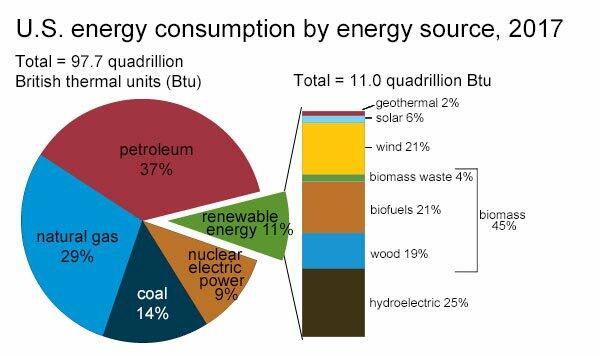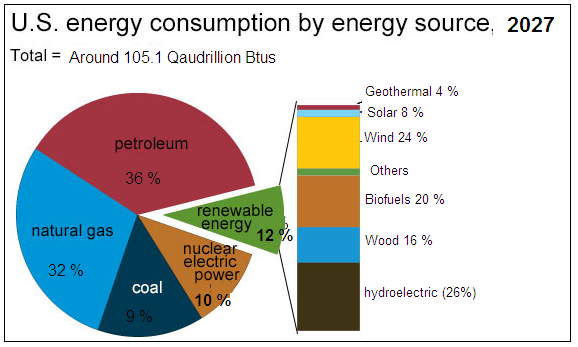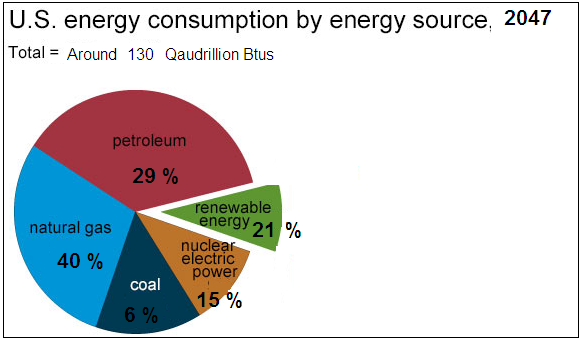Introduction
The changes experienced in different countries across the globe have led to new energy demands. This means that most of the sources of fuel might become depleted in the next few decades unless governments implement appropriate measures.
Currently, this growing need is met by the major fossil fuels, including natural gas, petroleum, and coal. The United States still grapples with numerous energy challenges despite the fact it has different sources. The country’s leading sources include natural gas, nuclear energy, and renewable sources. Unfortunately, the current energy mix is unsustainable and can affect the country’s future economic growth. This is the reason why it is in need of a superior energy policy. This paper proposes a viable energy mix that can meet America’s future energy demands.
Proposing a New Energy Policy for the United States
Current Energy Usage Mix
Over the years, the USA government has identified and diversified its energy sources in an attempt to meet its industrial and economic needs. Fossil fuels such as natural gas, petroleum, and coal play a significant role in supporting the country’s economic growth (Steeves & Ouriques, 2016). Although there are different units for measuring energy sources, the US uses a method called British thermal units (Btu). It is also considered to compare various energy types. In 2017, the country’s energy consumption stood at 97,728,000,000,0000,0000 (97.73 quadrillion) Btu (see Figure 1). This means that the United States has increased energy demand levels.

From the above chart, it is notable that the country’s energy sources can be grouped into geothermal, nuclear, solar, hydroelectric, and wind. It reveals that nuclear energy accounted for 9 percent of this country’s energy consumption in 2017 (see Figure 1). The consumption rate for petroleum was around 37 percent. Natural gas contributed around 29 percent to the country’s energy source during the same period. Coal constituted 14 percent of America’s energy consumption. Nuclear energy power accounted for 9 percent (Steeves & Ouriques, 2016). These renewable energy sources amounted to 11 percent: solar (6 percent), wood (9 percent), bio-fuels (21 percent), wind (21 percent), geothermal (2 percent), and hydroelectric (25 percent).
Optimal Future Energy Usage: 2027, 2037, and 2047
The current sources of energy in the United States sustain numerous operations and economic activities. According to Alrikabi (2014), the United States’ consumption rate is expected to rise by over 5 percent. This growth will meet the needs of its corporations and citizens. These possible changes mean that the future will look different as many countries begin to focus on the most appropriate initiatives to improve energy sustainability. Akan, Selam, Firat, Er Kara, and Özel (2015) believe that some of the leading sources of nonrenewable energy might become depleted in the future, thereby jeopardizing many economic activities.

By 2027, the current energy usage mix is expected to change slightly. Some experts indicate that the country’s dependency on natural gas might increase significantly (Akan et al., 2015). This means that the country will consume more natural gas than ever before. This change will be catalyzed by the desire to promote environmental conservation measures. The second possible development is that many industries will be in need of electric power than ever before. This means that the consumption for hydroelectric and geothermal power might increase by 2027 (see Figure 2). Petroleum use is expected to remain flat due to the production of fuel-efficient and electric cars. The use of coal as a major source of energy will also decrease.
From 2027 to 2037, the percentage use of various energy types might not change significantly. According to Steeves and Ouriques (2016), this decade will be driven by most of the predicted innovations and technologies by the year 2030.
The country’s reliance on coal and wood will decrease by less than 0.5 percent. Similarly, increased consumption rates might be witnessed for sources such as hydroelectric, natural gas, wind, geothermal, and other bio-fuels such as biogas. Akan et al. (2015) acknowledge that the projected rate of 36 percent for petroleum can stay unchanged towards 2037. The country’s economic, industrial, and business landscapes of 2027 are expected to remain the same.

Fortunately, the year 2047 is expected to present a different mix for energy use. The consumption of natural gas will have increased to around 40 percent (see Figure 3). The projected demand from electric power and industrial sectors will drive this change. For instance, new firms might emerge to generate energy for domestic consumption. Alrikabi (2014) believes that petroleum reliance will have diminished to 29 percent. The increased demand for renewable and sustainable energy will support this development. Coal consumption will decrease as more companies and industries begin to focus on renewable energy.
Discussion and Rationale
Economic Efficiency
By 2047, different organizations and industries will prefer specific energy types while others will become less sustainable. Several economic forces are expected to dictate this projection. For instance, the government has been focusing on evidence-based policies that can dictate the quality and efficiency of vehicles produced by different manufacturers. This has also been the same case for most of the industries associated with different consumer products. Some energy types such as coal will become uneconomically viable (Steeves & Ouriques, 2016). The amount of money required to manage, produce, and use these resources are unsustainable. This is the reason why their use will reduce significantly within the next 30 years.
Coal and petroleum
Changing economic trends are expected to catalyze the production of new products that meet specific emission requirements. This will apply for aircrafts, vessels, and vehicles. Such machines will use reduced amounts of fuel, thereby promoting sustainability initiatives. Technological developments associated with new economic patterns will result in better sources of energy. The benefits of these types are that they are easily available, reliable, and applicable in a wide range of economic settings or activities (Alrikabi, 2014). They can also be used domestically and promote wealth creation. However, they present these disadvantages: they are expensive, unsustainable, and result in increased pollution.
Wood
Although wood has been a leading source of energy for many centuries, chances are high that its use will reduce by 2040. The main advantage is that different sectors depend on it to manufacture their items and products (Akan et al., 2015). However, the type is unsustainable, expensive, and incapable of delivering superior economic outcomes.
Hydroelectric power, natural gas, and nuclear energy
The consumption rate for these sources will increase significantly. Some of them include hydroelectric power, natural gas, and nuclear energy. One of the outstanding observations is that these sources are renewable in nature. Geothermal energy and solar power are capable of supporting numerous sectors, domestic homes, and industries to achieve their objectives (Cheng, Yang, & Wang, 2016).
Different sectors are expected to form a major percentage of the United States’ economic landscape. Some of them include technology, innovation, and aviation (Steeves & Ouriques, 2016). These changes might influence the consumption rate for hydroelectric and geothermal power. The advantages associated with these sources include reliability, affordability, and sustainability. The disadvantages are that they are expensive to produce and require complex infrastructure. The efficiency of wind and solar energy also depend on changing weather patterns.
Environmental Impact
Natural gas
Future projections reveal that the consumption rate for this source will increase by 2047. This is the case true since this type is expected to meet the needs of many industries and populations. The advantages associated with this source are that they are less expensive, available, and capable of promoting economic growth (Cheng et al., 2016). However, the type is unsustainable, nonrenewable, and can contribute to environmental degradation.
Coal
This product will become less reliable in the future. This means that the overall national consumption will decrease by the year 2050. The source is available to many industries and citizens, less expensive, and easy to manage (Cheng et al., 2016). However, the energy type is known to produce dangerous chemicals that pollute the environment, destroy the ozone layer, and cause global warming.
Hydroelectric
The consumption of this fuel source is expected to rise in the future. The advantages are that it is sustainable and capable of promoting environmental conservation. It does not degrade the environment and can be renewed (Alrikabi, 2014). The main disadvantage is that it is unsustainable due to unpredictable weather patterns.
Petroleum
Experts believe that the USA’s reliance of petroleum products will decrease significantly in the future. The reason for this is because such sources pollute the environment. These are the major advantages of petroleum: accessibility to many people, affordable, and predictable (Cheng et al., 2016). Disadvantages range from emission of dangerous greenhouse gases that destroy the ozone layer to issues of sustainability and global warming.
Geothermal energy
This renewable energy type is expected to become a major source of energy for the United States. The outstanding advantage is that it has minimal impacts on the natural environment (Rule, 2014). The disadvantages are that it is expensive and might affect environmental integrity in the long run.
Wood
The reliance on wood energy is expected to reduce within the next four decades. The reason for this is that such a source results in environmental degradation and can result in changing weather or climatic patterns (Cheng et al., 2016). The main advantage is that the type is available to many people. It is also cheap to acquire.
Solar and wind
The use of these two energy sources will increase significantly in the future. The reason for this development is that they are available to the greatest number of people. The major advantages include low production cost, reliability, and affordability (Steeves & Ouriques, 2016). They also have very minimal impacts on the environment. The disadvantages are that they are expensive to produce and depend on changing weather patterns.
Corporate America
The above analysis has revealed that the United States’ sources of energy will have changed by the year2047. This projected development requires corporations and industrial stakeholders to implement evidence-based changes if they are to achieve their goals. The first issue to consider is the introduction of new systems and innovations that use most of the sustainable energy sources (Steeves & Ouriques, 2016). Many customers have become sensitive about issues such as emission indexes, sustainability, and environmental protection. American corporations should consider the need to produce goods and services using sustainable means.
They should also engage in continuous research in an attempt to change their business models accordingly. They should do so while at the same time focusing on the changing consumer needs (Cheng et al., 2016). Corporations should involve key stakeholders and propose better policies to ensure that they remain relevant in their respective industries.
American Consumers
The above predicted changes will affect many consumers in the United States. Customers should, therefore, focus on renewable energy sources such as solar, hydroelectric, and wind power. This consideration will make it easier for them to reduce their expenditures and achieve their potential (Rule, 2014). They should also focus on energy saving tips that can support the global environmental conservation objectives.
Another issue to consider is the need to acquire products and items that conserve energy. This means that they will compel manufacturers and corporations to produce superior items that promote sustainability. The issue of global warming is something that affects humanity (Alrikabi, 2014). These evidence-based changes will empower many Americans and ensure that they are on the frontline towards supporting their country’s future energy demands.
The Role of the Government
The projected future mix presents a scenario whereby many sectors prefer renewable energy sources. This direction will make America sustainable, promote economic performance, and reduce the current levels of pollution. This situation should encourage them to introduce appropriate regulations that compel industries, customers, and corporations to support this agenda. The proposed regulations should focus on critical issues, such as emission of greenhouse gases, sustainability, and economic effect. The laws should compel institutions to support renewable energy sources, including solar, wind, and hydroelectric power (Steeves & Ouriques, 2016). Additionally, the government should introduce new laws to discourage the use of unsustainable and environmentally-unfriendly fuels.
Another important thing is for the government to give subsidies to firms and organizations that undertake numerous researches to explore new energy sources. This is something meaningful since the country’s energy demand continues to increase. At the same time, there is a need for people to have sources that are reliable, cheap, and incapable of destroying the natural environment. Such subsidies will empower the targeted firms and make it easier for them to address most of the challenges the country faces. It would also be appropriate to ensure that the proposed subsidies are available to both US-based and international firms (Rule, 2014). Such energy sources will ensure that the world minimizes the use of unsustainable energy sources. These measures will reduce the current level of environmental degradation.
Conclusion
The above discussion has revealed that the United States’ energy consumption mix is expected to change significantly by 2047. Each of the sources identified above has both economic and environmental implications. This is a clear indication that such considerations should inform the decision to increase or reduce the production of a given energy type. The introduction of better policies and subsidies will support the utilization of renewable energy types, promote economic development, and conserve the natural environment.
References
Akan, M. Ö., Selam, A. A., Firat, S. Ü., Er Kara, M., & Özel, S. (2015). A comparative analysis of renewable energy use and policies: Global and Turkish perspectives. Sustainability, 7(12), 16379-16407. Web.
Alrikabi, N. K. (2014). Renewable energy types. Journal of Clean Energy Technologies, 2(1), 61-64. Web.
Cheng, M., Yang, M., & Wang, Y. (2016). American’s energy future: An analysis of the proposed energy policy plans in presidential election. Energies, 9(12), 1000-1016. Web.
Rule, T. A. (2014). Solar, wind and land: Conflicts in renewable energy development. New York, NY: Routledge.
Steeves, B. B., & Ouriques, H. R. (2016). Energy security: China and the United States and the divergence in renewable energy. Contexta Internacional, 38(2), 643-662. Web.